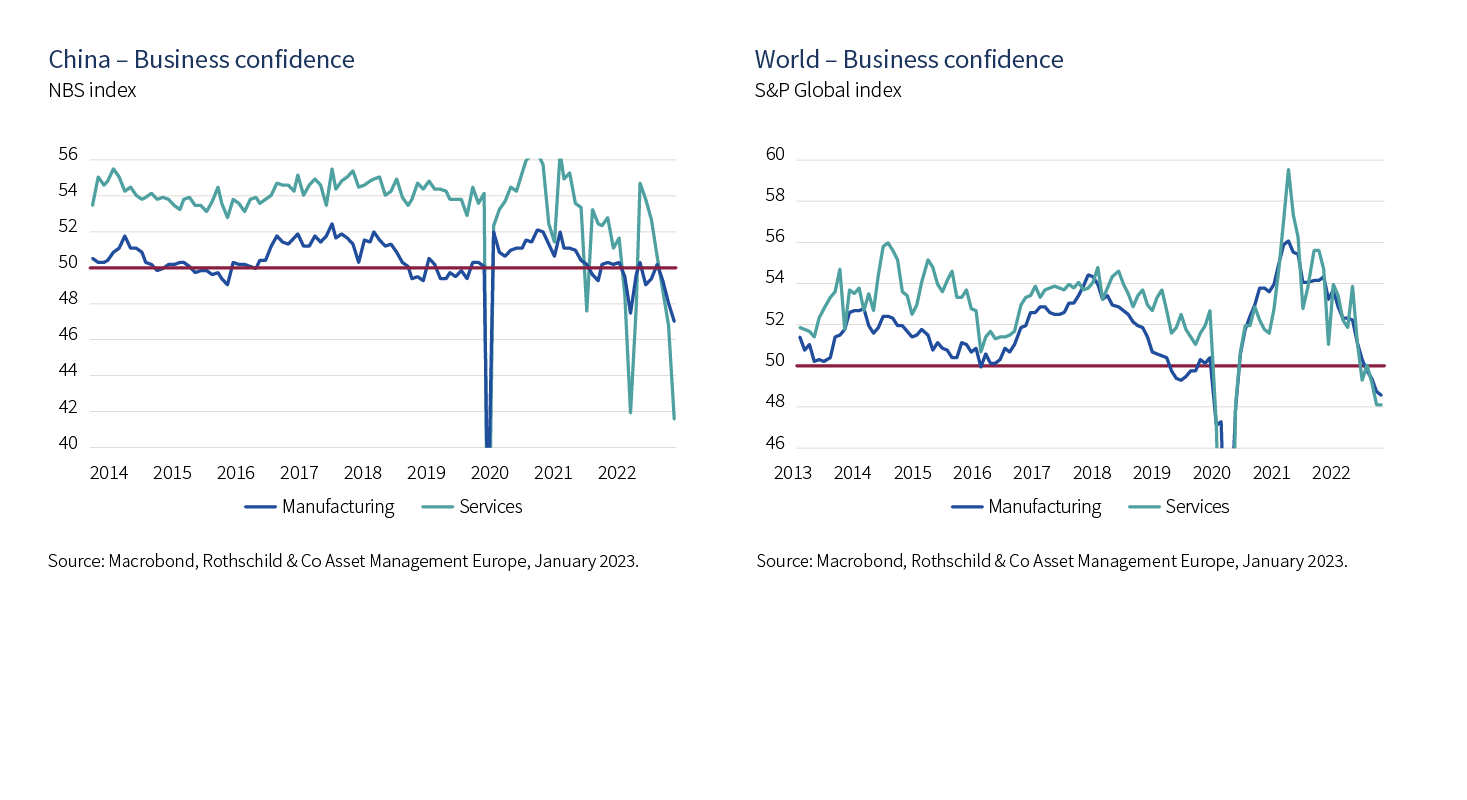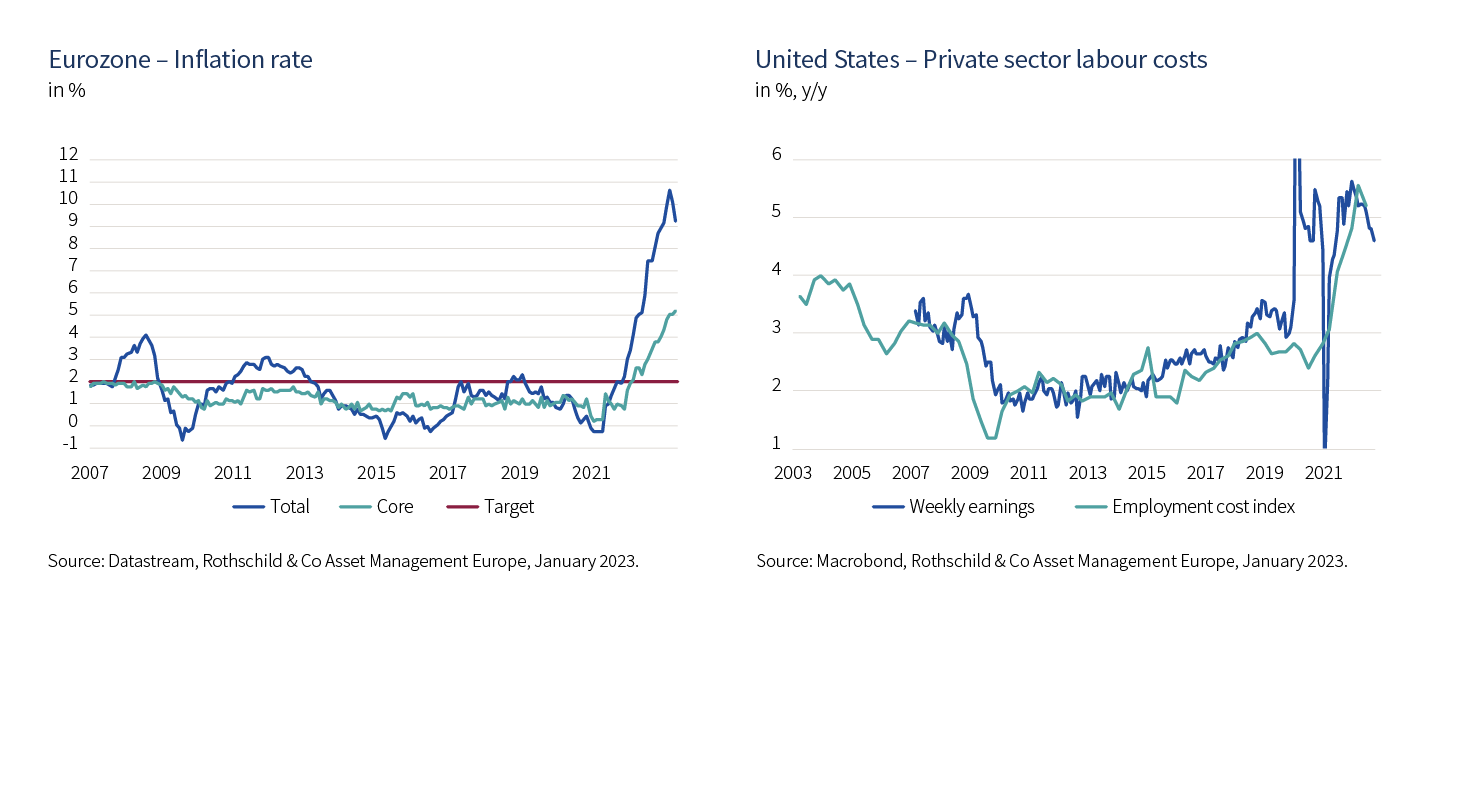Monthly Macro Insights | January 2023

" As expected, a fall in global inflation is underway, but labour markets remain tight. Correspondingly, the dilemma for central banks has become extensively complex amid an unintended easing of financial conditions as investors have become increasingly optimistic that a monetary policy pivot will take shape in the next few months and China will re-emerge as an engine of the global economy."
China’s V-shaped growth hope
China’s sudden and rapid relaxation of stringent Covid-related restrictions appears likely to deliver a deeper near-term contraction than expected as the unprecedented surge in infections has resulted in a notable hit to the economy. In the manufacturing sector, business confidence fell to 47 in December from 48 in November(1), suggesting activity shrank for the third consecutive month and at the sharpest pace in nearly three years. The nonmanufacturing confidence index fell to 41.6 from 46.7 in November, also marking the lowest reading since February 2020(2). In fact, the weeks before the Lunar New Year holiday will be challenging for the service sector as mobility could be negatively hit by people’s fear of catching Covid. Surging infections could also cause temporary labour shortages and increased supply chain disruptions, with global repercussions on price pressures.
However, new cases might peak in early February, directly after the holiday, and the economy would thus recover from Q2. Furthermore, the China Banking and Insurance Regulatory Commission has stepped up financial support to small and private businesses in the catering and tourism sectors that were hardest hit by the pandemic and, more broadly, policymakers have set out plans to expand domestic consumption and investment. That said, the export sector is still facing headwinds from weakening external demand on the back of growing global recession fears amid rising interest rates, inflation and the war in Ukraine.

Monetary dissonance with markets
The S&P Global manufacturing business confidence index was marginally lower in December to 48.6 with broad-based weakness as 75% of the countries covered by the index are below the 50 boom-bust line, while confidence remained stable in the services sector at 48.1(3) also in contraction territory. Although the levels remain depressed, investors hope the relative stabilisation points at a bottoming in the global growth slowdown at the turn of the year. However, the new orders sub-index remains fairly depressed (47.7) and actually ticked lower in December, challenging this view. On the inflation front, input (59.7) and output (55.1) price sub-indexes stayed elevated in December, but the steady declines in the past few months are an encouraging sign that disinflation continues to gather momentum(4). The slide was partly due to decelerating economic growth, but also because of fading commodity prices associated with the Ukraine war and the reconnection of supply chains. Yet, the outlook remains murky, in part due to the strength of the labour market.
The ECB retained a hawkish(5) stance at the December meeting, even as the Governing Council decided to raise interest rates by 50 bps instead of 75 bps as in the previous two meetings, and cautiously began quantitative tightening(6). It is likely that headline inflation has peaked in the Eurozone, as energy contributions have started to ease due to mild winter weather and the successful reserves accumulation. However, although European natural gas prices fell back to their pre-Ukrainian war levels, the impact on consumer energy prices is uncertain as governments gradually unwind earlier programmes designed to insulate consumers from big energy price swings. What’s more, underlying price pressures are not showing signs of abating as the flash reading for December suggests that core inflation may be stickier, reaching the highest level (5.2%) since the launch of the euro, while the unemployment rate remained at an all-time low at the end of 2022. Incidentally, the latest ECB inflation forecast was revised up, likely reflecting a pick-up in wage pressure, and 2024 core inflation was projected at 2.8%(7), significantly higher than target and suggesting the ECB may have to hike rates higher than market participants anticipate.

In the US, labour market data are sending mixed signals. Jobs growth remained solid and the unemployment rate unexpectedly edged back down in December to its 3.5% cyclical lows(8). Furthermore, job openings eased only slightly in November, and the recent pace of decline is much slower than earlier in 2022, while the quits rate ticked up to historically extreme levels, both consistent with a very tight labour market. On the other hand, average hourly earnings growth has somewhat moderated to 4.6% y/y in December, softer than the recent peak rate of 5.6% back in March(8). This development, combined with signs of slower growth momentum in both the ISM manufacturing and services business confidence indexes(9), instilled hope that the Fed can indeed achieve a soft landing and ease off the brake at some point this year. Fed funds(10) futures markets are now pricing in a terminal rate of 5% by H1 2023, and thereafter a -40 bps reduction by the end of the year.
Yet, the latest Fed meeting minutes showed that, in notable contrast with market pricing, none of the 18 members anticipated that it would be appropriate to begin reducing the fed funds rate in 2023 given continued risks for more persistent inflation. Indeed, even after the fall in the headline inflation in the past months, they stressed the need for substantially more evidence to become comfortable that the trend was on a sustained downward path. What’s more, Fed officials generally agreed that a restrictive policy stance would need to be maintained for some time as historical experience cautioned against prematurely loosening monetary policy. Accordingly, because monetary policy works importantly through financial markets, an unwarranted easing in financial conditions, especially if driven by a misperception by the market participants of its reaction function, could complicate the Fed’s effort to bring inflation to target.

(1) Above 50, it reflects an expansion of activity, below 50, a contraction.
(2) Source: National Bureau of Statistics, January 2023.
(3) Source: S&P Global, January 2023.
(4) Source: ISM, January 2023.
(5) Less accommodating monetary policy stance aimed at fighting inflation.
(6) More restrictive monetary policy.
(7) Source: Eurostat, January 2023.
(8) Source: U.S. Bureau of Labor Statistics, January 2023.
(9) Purchasing Managers’ Index, an indicator reflecting the confidence of purchasing managers in an industry.
(10) Funds deposited by commercial banks to meet reserve requirements set by the Fed.
Press Contacts:
Gunther De Backer
Olivier Duquaine